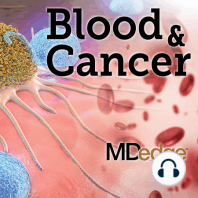39 min listen
Sickle cell update: Treating pain and progress toward cure
FromBlood & Cancer
ratings:
Length:
26 minutes
Released:
Jan 23, 2020
Format:
Podcast episode
Description
When it comes to treating pain related to sickle cell disease, consider the underlying factors, from constipation to compression spine deformity. That’s just some of the advice from Ifeyinwa Osunkwo, MD, of Atrium Health and Levine Cancer Institute in Charlotte, N.C. She joins host David H. Henry, MD, of Pennsylvania Hospital, Philadelphia, to discuss her tips for treating pain and other complications of sickle cell disease. Dr. Osunkwo also provides an update on progress toward a cure in sickle cell disease that could be available to a large number of patients. Plus, in Clinical Correlation, Ilana Yurkiewicz, MD, of Stanford (Calif.) University, talks about why treating patients with cancer doesn’t make her sad. * * * Treating pain in sickle cell: In sickle cell disease, patients have acute episodes of vaso-occlusive crisis, as well as chronic pain. Consider whether the pain symptoms are an acute exacerbation of their chronic pain, an independent acute episode of pain, or chronic pain. In her practice, Dr. Osunkwo has moved to less chronic opioid use and more adjuvant use. She says treat the pain but look for the reason underlying it. The pain could be a result of bone damage, a compression spine deformity, constipation, or other factors related to their disease or the treatment. Consider the impact of opioid withdrawal after receiving a high dose in the hospital. Treating acute chest syndrome: Acute chest syndrome is usually not subtle in its presentation. It is acute and includes fever, pain, difficulty breathing or shortness of breath, hypoxia, and the patient looks sick. Consider their last chest x-ray and look for changes. Is this a new pulmonary infiltrate? This is a patient who should be transfused to get them out of distress. Most of acute chest syndrome cases happen 3 days into a hospital admission. Developments in sickle cell treatment: Two new drugs to treat sickle cell symptoms were approved in the United States in 2019: voxelotor (Oxbryta) to increase hemoglobin and crizanlizumab-tmca (Adakveo) to reduce the frequency of vaso-occlusive crisis. What is coming next? Researchers are working on potential cures for sickle cell that would be available to patients on a widespread basis. That includes haploidentical transplant and gene therapy. American Society of Hematology guidelines on the treatment of sickle cell complications. * * * For more MDedge Podcasts, go to mdedge.com/podcasts Email the show: podcasts@mdedge.com Interact with us on Twitter: @MDedgehemonc David Henry on Twitter: @davidhenrymd Ilana Yurkiewicz on Twitter: @ilanayurkiewicz
Released:
Jan 23, 2020
Format:
Podcast episode
Titles in the series (100)
Treating colorectal cancer in the COVID-19 era: Oncologists are now weighing the benefits of treating cancer patients against the risk of exposing them to SARS-CoV-2. , of University of Oxford (England) talks with podcast host , of Pennsylvania Hospital in Philadelphia, about how to treat... by Blood & Cancer
